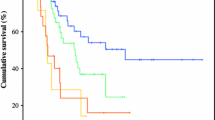Abstract
Background: There is controversy about the extent of groin dissection necessary (whether superficial or radical) and about its utility when the deep nodes are affected.
Methods: A total of 198 groin dissections (1977–1991) were reviewed; 94 (48%) were superficial and 104 (52%) were radical dissections. Of 72 patients with palpable positive inguinal nodes, 31 (43%) had involvement of the deep nodes; of 39 patients with nonpalpable, histologically positive inguinal nodes, seven (18%) had or later manifested involvement of the deep nodes.
Results: The mean number of positive nodes (median) in the group with clinically palpable disease was six (two), and in the group with occult disease the number was two (one). The estimated overall (disease-free) 5-year and 10-year survival rates for patients with negative nodes were 73% (67%) and 64% (58%), respectively, and for those with positive nodes they were 36% (27%) and 30% (23%), respectively. Survival was significantly poorer for patients with positive nodes (p<0.0001). The respective 5-year and 10-year survival rates for patients with positive nodes and involvement of the inguinal nodes only were 41% (33%) and 36% (29%), and for those with involvement of the inguinal and deep nodes the rates were 28% (17%) and 19% (13%). Survival was significantly poorer for patients with deep node involvement (p=0.006).
Conclusions: The survival rates after therapeutic groin dissection are substantial and unattainable with any other treatment at the present time. Incontinuity dissection of the deep nodes is advisable in the presence of palpable inguinal nodes, since the incidence of deep node involvement is considerable and the survival rate appreciable after removal of involved deep nodes.
Similar content being viewed by others
References
Breslow A. Thickness, cross-sectional area, and depth of invasion in the prognosis of cutaneous melanoma.Ann Surg 1970;172:902–8.
Clark WH, From L, Bernadino EA, Mihm MC. The histogenesis and biologic behavior of primary human malignant melanomas of the skin.Cancer Res 1969;29:705–26.
Balch CM, Murad TM, Soong S-J, Ingalls AL, Halpern NB, Maddox WA. A multifactorial analysis of melanoma: prognostic histopathological features comparing Clark's and Breslow's staging methods.Ann Surg 1978;188:732–42.
Johnson OK, Emrich LJ, Karakousis CP, Rao U, Greco WR. Comparison of prognostic factors for survival and recurrence in malignant melanoma of the skin: clinical stage I.Cancer 1985;55:1107–17.
Balch CM, Soon S-J, Milton GW, Shaw HM, McGovern VJ, Murad TM, McCarthy WH, et al. A comparison of prognostic factors and surgical results in 1,786 patients with localized (stage I) melanoma treated in Alabama, USA, and New South Wales, Australia.Ann Surg 1984;196:677–84.
Balch CM. The role of elective lymph node dissection in melanoma: rationale, results and controversies.J Clin Oncol 1988;6:163–72.
Veronesi U, Adamus J, Bandiera DC, Brennhovd IO, Cacerse E, Cascinelli N, Claudio F, et al. Inefficacy of immediate node dissection in stage I melanoma of the limbs.N Engl J Med 1977;279:627–30.
Sim FH, Raylow WF, Ivins JC, Pritchard DJ, Soule EH. A prospective randomized study of the efficacy of routine elective lymphadenectomy in management of malignant melanoma: preliminary results.Cancer 1978;41:948–56.
Balch CM, Murad TM, Soon S-J, Ingalls AL, Richards PC, Maddox WA. Tumor thickness as a guide to surgical management of clinical stage I melanoma patients.Cancer 1979;43:883–8.
Balch CM, Urist MM, Karakousis CP, Smith TJ, Temple WJ, Drzewiecki K, Jewell WR, et al. Efficacy of 2 cm surgical margin for intermediate thickness melanomas (1–4 mm): results of a multi-institutional randomized surgical trial.Ann Surg 1993;218:262–9.
Gumport SL, Harris MN. Results of regional lymph node dissection for melanoma.Ann Surg 1974;179:105–8.
Morton DL, Roe DJ, Cochran AJ. Melanoma in the Western United States: experience with stage II melanoma at the UCLA Medical Center. In: Balch CM, Milton GW, eds.Cutaneous melanoma. Philadelphia: JB Lippincott, 1985:419–30.
Karakousis CP, Goumas W, Rao U, Driscoll DL. Axillary node dissection in malignant melanoma.Am J Surg 1991;162:202–7.
Kaplan EL, Meier P. Nonparametric estimation from incomplete observations.J Am Stat Assoc 1958;53:457–86.
Cox DR. Regression models and life-tables.J Royal Stat Soc 1972;34B:187–220.
Coit DG, Peters M, Brennan MF. A prospective randomized trial of perioperative cefazolin treatment in axillary and groin dissection.Arch Surg 1991;126:1366–72.
Papachristou D, Fortner JG. Comparison of lymphedema following incontinuity and discontinuity groin dissection.Ann Surg 1977;185:13–6.
Morton DL, Wen D-R, Wong JH, Economou JS, Cagle LA, Storm K, Foshag LJ, et al. Technical details of intraoperative lymphatic mapping for early stage melanoma.Arch Surg 1992;127:392–99.
Karakousis CP. Ilioinguinal lymph node dissection.Am J Surg 1981;141:299–303.
Karakousis CP, Emrich LJ, Driscoll DL, Rao U. Survival after groin dissection for malignant melanoma.Surgery 1991;109:119–26.
Illig L, Aigner KR, Biess B, et al. Diagnostic excision of the Rosenmuller's node: screening for occult metastases before elective regional lymph node dissection in patients with lower limb melanoma?Cancer 1988;61:1200–6.
Coit DG, Rogatko A, Brennan MF. Prognostic factors in patients with melanoma metastatic to axillary or inguinal nodes: a multivariate analysis.Ann Surg 1991;214:627–36.
Author information
Authors and Affiliations
Rights and permissions
About this article
Cite this article
Karakousis, C.P., Driscoll, D.L., Rose, B. et al. Groin dissection in malignant melanoma. Annals of Surgical Oncology 1, 271–277 (1994). https://doi.org/10.1007/BF02303564
Received:
Accepted:
Issue Date:
DOI: https://doi.org/10.1007/BF02303564




